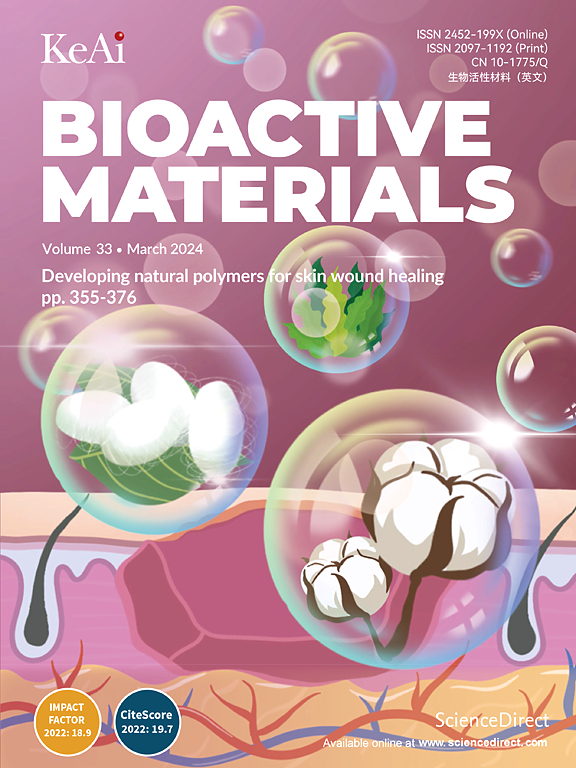负载il -1β靶向纳米体的ros反应水凝胶对心肌梗死的改善作用。
IF 18
1区 医学
Q1 ENGINEERING, BIOMEDICAL
引用次数: 0
摘要
心肌微环境严重制约了心肌再生策略治疗心肌梗死(MI)的效果。MI治疗的前瞻性方法包括清除活性氧(ROS)以减轻氧化应激损伤和促进巨噬细胞向再生M2表型极化的联合策略。在这项研究中,我们制造了一种ros敏感的水凝胶,用于输送我们之前设计的IL-1β-VHH用于心肌修复。在小鼠和大鼠心肌梗死模型中,将治疗凝胶注射到心包腔内,有效地播散在心脏表面,形成原位心外膜贴片。水凝胶释放的IL-1β-VHH具有渗透心肌的潜能。我们的研究结果表明,这种梗死靶向凝胶可以粘附在受损的心脏组织上,并增加抗il -1β抗体的数量。此外,抗IL-1β水凝胶通过中和IL-1β和诱导心肌梗死区域内的m2型极化来保护心肌细胞免于凋亡,从而促进治疗性心脏修复。我们的研究结果强调了这种协同综合治疗方式在心肌梗死管理中的有效性,并展示了其促进梗死心脏恢复的巨大潜力。本文章由计算机程序翻译,如有差异,请以英文原文为准。

Injection of ROS-Responsive Hydrogel Loaded with IL-1β-targeted nanobody for ameliorating myocardial infarction
The cardiac microenvironment profoundly restricts the efficacy of myocardial regeneration tactics for the treatment of myocardial infarction (MI). A prospective approach for MI therapeutics encompasses the combined strategy of scavenging reactive oxygen species (ROS) to alleviate oxidative stress injury and facilitating macrophage polarization towards the regenerative M2 phenotype. In this investigation, we fabricated a ROS-sensitive hydrogel engineered to deliver our previously engineered IL-1β-VHH for myocardial restoration. In mouse and rat models of myocardial infarction, the therapeutic gel was injected into the pericardial cavity, effectively disseminated over the heart surface, forming an in situ epicardial patch. The IL-1β-VHH released from the hydrogel exhibited penetrative potential into the myocardium. Our results imply that this infarct-targeting gel can adhere to the damaged cardiac tissue and augment the quantity of anti-IL-1β antibodies. Moreover, the anti-IL-1β hydrogel safeguards cardiomyocytes from apoptosis by neutralizing IL-1β and inducing M2-type polarization within the myocardial infarction regions, thereby facilitating therapeutic cardiac repair. Our results emphasize the effectiveness of this synergistic comprehensive treatment modality in the management of MI and showcase its considerable potential for promoting recovery in infarcted hearts.
求助全文
通过发布文献求助,成功后即可免费获取论文全文。
去求助
来源期刊

Bioactive Materials
Biochemistry, Genetics and Molecular Biology-Biotechnology
CiteScore
28.00
自引率
6.30%
发文量
436
审稿时长
20 days
期刊介绍:
Bioactive Materials is a peer-reviewed research publication that focuses on advancements in bioactive materials. The journal accepts research papers, reviews, and rapid communications in the field of next-generation biomaterials that interact with cells, tissues, and organs in various living organisms.
The primary goal of Bioactive Materials is to promote the science and engineering of biomaterials that exhibit adaptiveness to the biological environment. These materials are specifically designed to stimulate or direct appropriate cell and tissue responses or regulate interactions with microorganisms.
The journal covers a wide range of bioactive materials, including those that are engineered or designed in terms of their physical form (e.g. particulate, fiber), topology (e.g. porosity, surface roughness), or dimensions (ranging from macro to nano-scales). Contributions are sought from the following categories of bioactive materials:
Bioactive metals and alloys
Bioactive inorganics: ceramics, glasses, and carbon-based materials
Bioactive polymers and gels
Bioactive materials derived from natural sources
Bioactive composites
These materials find applications in human and veterinary medicine, such as implants, tissue engineering scaffolds, cell/drug/gene carriers, as well as imaging and sensing devices.
 求助内容:
求助内容: 应助结果提醒方式:
应助结果提醒方式:


